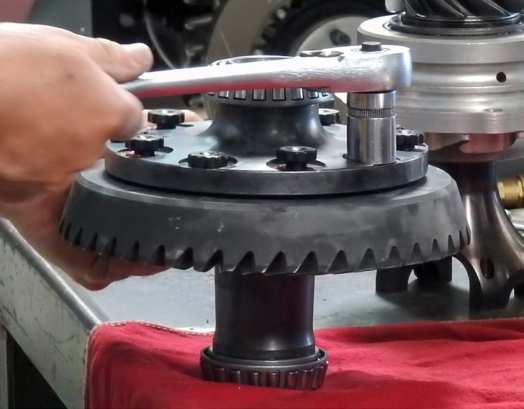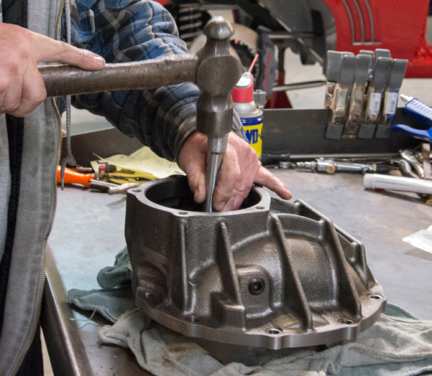DIFFERENTIALS / GEARS

When running a race car in so many different types of racing since 1988, and trying to get the right amount of gear on the low end to get enough steam to attain a few extra mph on the top end, you’re bound to amass an expansive collection of gears. The gear shelf at Dave’s shop looks like the gear aisle at Summit Racing. The ring-and-pinion sets range from 2.47 to 4.85.
There are two different center section setups. Both are documented in this section. For the first time in Big Red’s history, Tim ordered Strange Engineering’s HD Pro Aluminum cases. He chose to run these at Pikes Peak instead of the traditional nodular iron cases the team always has run. Tim will continue building center sections for the Land Speed/Top Speed mode with the nodular iron cases. The Strange Pro Lightweight spool for the Land Speed/Top Speed mode visually is identified with the additional lightening holes drilled in the ring gear flange. Tim presses brand-new carrier bearings on the spool, being sure to only press on the inside sleeve of the bearing, not the outer bearing cage. Tim has seen many bolts come loose after a few runs because the washers allow the bolts to work loose. He uses ARP’s standard Chevrolet flywheel bolts because they have a wider head
and a shoulder to center the bolt in the spool. These ARP bolts are the perfect length. He’s had success using this method, with over 100 rearends since he started building them for Big Red.
Tim deburrs the ring gear teeth, then bolts the ring gear to the spool. Tim had an old axle with a plate welded to it, which is clamped in a bench vise. The axle stub on the bench allowed Tim to secure the spool so he can torque the ring gear without it slipping. Tim drove the new tail bearing (pinion pilot bearing) into the case with a socket that’s the size of the outer edge of the bearing. Driving this bearing into the case via the inner race will damage the bearing. Tim assembled the pinion support, then lubricated it with gear lube. He likes to start by removing the O-ring seal from the pinion support. It should not be installed until the gear lash has been finished completely. Otherwise, the seal could be damaged when removing it during the lash-setting process. He installed the pinion support with a 0.015-inch shim and adjusts it from there. Once he confirmed the pinion depth is correct, it was time to start working on the gears.
